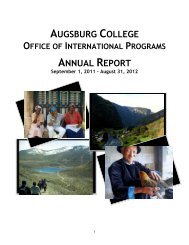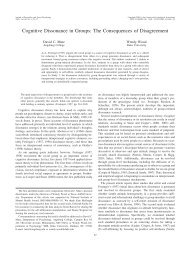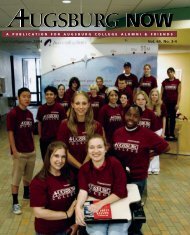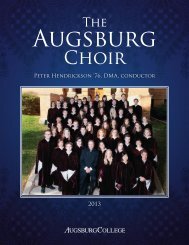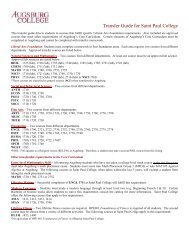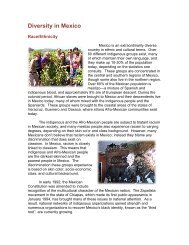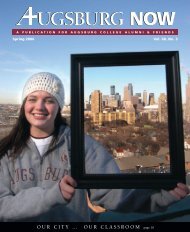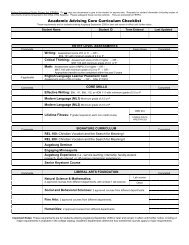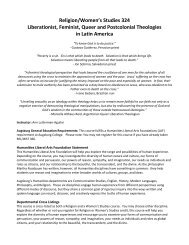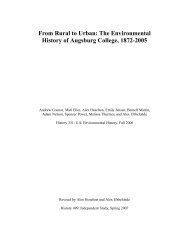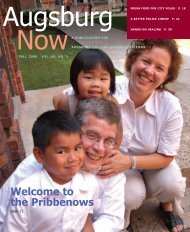Download the Fall 2004 PDF - Augsburg College
Download the Fall 2004 PDF - Augsburg College
Download the Fall 2004 PDF - Augsburg College
You also want an ePaper? Increase the reach of your titles
YUMPU automatically turns print PDFs into web optimized ePapers that Google loves.
core curriculumA LESSON IN COMPUTERS AND CULTUREBusiness/MIS professor Lee Clarketeaches a first-year course, MIS 175Principles of Computing for Business.It’s an introductory course formanagement information systems (MIS)students to learn Microsoft Officeprograms and how <strong>the</strong>y are used inbusiness to reach goals and solvebusiness problems.The course is designed to include anEngaging Minneapolis component. Thatpart of <strong>the</strong> course, which Clarke calls<strong>the</strong> experience “text,” involves apartnership with <strong>the</strong> Cedar-RiversidePlaza Residents Resource Center. There,<strong>Augsburg</strong> students work 15 hours persemester as assistants in <strong>the</strong> computerclass or open lab. The residents aremostly Somali refugees; many havelimited English skills and some have nevertouched a computer.Clarke requires three assignments thatconnect <strong>the</strong> subject matter with <strong>the</strong>service experience. In one, students reflecton <strong>the</strong> digital divide with its issues oftechnology “haves” and “have-nots” andtalk about how <strong>the</strong> Resource Center helps<strong>the</strong> residents overcome <strong>the</strong>se barriers. Thelast assignment asks <strong>the</strong> students to reflectpersonally—what <strong>the</strong>y learned at <strong>the</strong>center and how it relates to <strong>the</strong>ir course.Freshman business student Jerrad Honstad helps a Somali womanat Riverside Plaza learn computer skills.One student wrote, “This experiencehelped me to meet [new immigrants], andI can look at <strong>the</strong> world and America in awhole new light. … I feel that you canlearn more in <strong>the</strong> short 15 hours I worked<strong>the</strong>re than you can in some classes you goto daily for a whole semester.”Ano<strong>the</strong>r student talked about anunforgettable moment after helping anolder man learn to use Microsoft Word.“Then one day he came in quite as usualbut with a huge smile on his face,” <strong>the</strong>student wrote. “He handed mea piece of paper that said,‘Thanks for helping me.’ Itwas typed in real big, boldletters. He <strong>the</strong>n looked at meand said, ‘Look, I learned howto use Word.’ ”A disabled studentthought he would not be ableto help, but later wrote,“Little did I know that I wasabout to prove myself wrong,very wrong.” The computerinstructor told him that sincehe was not able to actually do<strong>the</strong> computing for <strong>the</strong>residents, it was morebeneficial for <strong>the</strong>m, since<strong>the</strong>y had to listen to <strong>the</strong> student’sexplanation and do <strong>the</strong> work <strong>the</strong>mselves.For <strong>the</strong> young business students inhis class who have always had computersin <strong>the</strong>ir lives, Clarke knows <strong>the</strong>y are nowmore aware of <strong>the</strong> disparities of wealthand technology in <strong>the</strong> world. Theexperience of working with newimmigrants, many of <strong>the</strong>m close to <strong>the</strong>students’ grandparents’ ages, also gave<strong>the</strong>m a greater appreciation of cultureand citizenship.KeystonePUTTING ITTOGETHERIf Engaging Minneapolis is <strong>the</strong> bookendon <strong>the</strong> front end of an <strong>Augsburg</strong>education, <strong>the</strong> keystone experience is<strong>the</strong> final bookend. During <strong>the</strong> years inbetween, students delve into a major,build professional as well as life skills,apply <strong>the</strong>ir classroom learning, explorefaith, and experience <strong>the</strong> city. Thekeystone course usually occurs in <strong>the</strong>senior year, close to graduation.The keystone in <strong>the</strong> <strong>Augsburg</strong> Core,as in architecture, provides <strong>the</strong> shapeand support to <strong>the</strong> structural elementsof <strong>the</strong> arch. It connects <strong>the</strong> broad liberalarts foundation with <strong>the</strong> professionalskills and <strong>the</strong> in-depth study in <strong>the</strong>major. It helps students begin <strong>the</strong>transition to <strong>the</strong>ir after-college life.Learning goals include a revisiting of<strong>the</strong> critical conversations about vocationthat were begun in <strong>the</strong> first Search forMeaning course. Attention is paid toreflection on vocation, leadership, andservice in a diverse world.The value of <strong>the</strong> keystone, says MISprofessor Nora Braun, who piloted anMIS keystone course, is that it’s timefocused on thinking about all <strong>the</strong> piecesin an <strong>Augsburg</strong> education and what <strong>the</strong>student has done with <strong>the</strong>m. “It’s areflection and a pulling toge<strong>the</strong>r of <strong>the</strong>total experience in and out of <strong>the</strong>classroom.” Braun asks her students towrite an “education autobiography” thatreflects on <strong>the</strong> identified outcomes of<strong>the</strong>ir <strong>Augsburg</strong> education.<strong>Fall</strong> <strong>2004</strong>23



